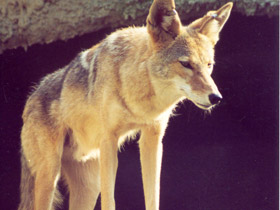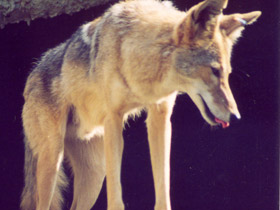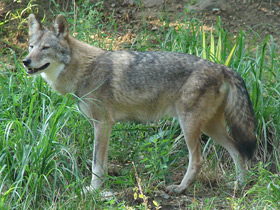The coyote, American jackal, the prairie wolf and the brush wolf (Canis latrans)
The coyote (Canis latrans) is a species of canine native to North America. It is smaller than its close relative, the wolf, and slightly smaller than the closely related eastern wolf and red wolf. It fills much of the same ecological niche as the golden jackal does in Eurasia. The coyote is larger and more predatory and was once referred to as the American jackal by a behavioral ecologist. Other historical names for the species include the prairie wolf and the brush wolf.
Appearance
Canis latrans is a species of carnivorous mammal of the family Canidae.
This predator is considerably smaller in size than the wolf: body length is 75-100 cm, height at the shoulders just over 50 cm, weight 13-21 kg, and males are slightly larger than females. The coyote has erect ears and a long (about 30 cm) fluffy tail, which it holds in the run at a 45-degree angle, in contrast to the wolf. The coyote's coat is thicker and longer than that of the wolf: the hairs are 8 cm on the back and 12 cm between the shoulder blades.
Habitat area
With massive deforestation and the extermination of its main food competitor, the wolf, Canis latrans has spread over a much wider area than its natural historical range. A century ago, Canis latrans was a native prairie dweller; today it is found almost everywhere from Alaska to Central America, and in the United States it inhabits 49 of the 50 states. The coyote lives in both deserted and populated areas, and is even found outside Los Angeles. This animal has an incredible capacity for ecological adaptation and resilience, which has allowed it to cover two-thirds of the continent in less than 30 years. In its vast range, this predator has 19 subspecies.
Nutrition and peculiarities
Canis latrans is the most athletic of the wild canines: it can jump 2-4 m and run at 40-50 km/h; it can reach speeds of up to 65 km/h over short distances and cover long distances. This member of the canine family has an excellent development of all its senses: it can see up to 200 m at any time of the day.
Canis latrans is omnivorous and very food insecure. In grasslands, it plays a role similar to that of the jackal in Old World biocenoses. About 90% of its diet consists of animal foods: hares, rabbits, grasshoppers, groundhogs, moles and small rodents. The coyote also preys on raccoons, ferrets, opossums and beavers; it eats birds (pheasants) and insects; it swims well and captures aquatic life, such as fish, frogs and newts.
In late summer and autumn, it eats berries, fruits (watermelon, grapefruit, apples, persimmons) and peanuts; in winter, in northern areas, it eats carrion and follows herds of large ungulates, devouring fallen and weakened animals.
In North American Indian mythology, Canis latrans appears as a cunning, intelligent and mischievous deity. In Navajo mythology he is also the deity of hunting, war and love, and the inventor of witchcraft. In creation myths, Canis latrans sometimes creates the world and the first humans by kicking up a lump of earth, excrement or a blood clot. Several North American Indian tribes consider Canis latrans a sacred totem animal, which is forbidden to be hunted for religious reasons.
Social behaviour and reproduction
Canis latrans hunt mainly at dusk alone or in pairs, sometimes in flocks on large game (caribou, wapiti).
These predators are very intelligent. The distribution of roles in hunting packs is similar to that of wolves; the bulls lead the game to ambush or chase it in turn. Each Canis latrans, pair or family group, has its own territory, the centre of which is a den or den.
The members of the herd regularly mark the boundaries of their territory with urine. The main social unit in Canis latrans is the permanent pair, although solitary animals and herds are common. The latter form where Canis latrans are abundant and small rodents are scarce, and predators are forced to join together to hunt larger animals.
Gestation in Canis latrans lasts 60-65 days, after which 5-10 pups (sometimes up to 19) are born in the den. Coyotes often have alternative dwellings, where the parents take the pups in case of danger. For the first few days, the female does not leave the den, and food is provided by the male. The adults feed the cubs by burping semi-digested food for them. In autumn, the young Canis latrans become independent; the males usually leave and the females usually remain in the herd.
Subspecies
The following subspecies are recognised:
Canis latrans latrans - The largest subspecies; it has rather pale fur and bears large molars and carnassials. The Great Plains from Alberta, Manitoba, and Saskatchewan south to New Mexico and the Texas Panhandle.
Canis latrans cagottis - Similar to Canis latrans peninsulae, but larger and redder in color; it has shorter ears, larger teeth, and a broader muzzle. States of Oaxaca, San Luis Potosi, Puebla, and Veracruz in Mexico.
Canis latrans clepticus - A small subspecies, it has reddish summer fur and a short, broad skull. Northern Baja California and southwestern California.
Canis latrans dickeye - A large subspecies, it equals Canis latrans lestes in size, but has smaller teeth and darker fur. Originally only known from Cerro Mogote, 3.2 km (2 mi) west of the Goascorán River in La Unión, El Salvador; in January 2013, it expanded its range southward into southern Panama.
Canis latrans frustror - This subspecies is similar to Canis latrans peninsulae, but larger and paler, with shorter ears and a longer muzzle. Southeastern and extreme eastern Kansas, Oklahoma, Texas, Missouri, and Arkansas.
Canis latrans goldmani - The largest of the Mexican coyotes, it approaches Canis latrans latrans in size, but has a shorter muzzle. Known only from San Vicente, Chiapas, Mexico, near the Guatemalan border, though it could be the coyote of western Guatemala.
Canis latrans hondurensis - A small, rufous-colored subspecies, it has coarse, thin fur and a broad skull. Known only from the open country northeast of Archaga, north of Tegucigalpa.
Canis latrans impavidus - This canid is similar to Canis latrans cagottis in color, but much larger. Southern Sonora, extreme southwestern Chihuahua, western Durango, western Zacatecas, and Sinaloa.
Canis latrans incolatus - A medium-sized subspecies, it has cinnamon-colored fur and a more concave skull than C. l. latrans. Boreal forests of Alaska, the Yukon, the Northwest Territories, northern British Columbia, and northern Alberta.
Canis latrans jamesi - Much paler than Canis latrans mearnsi, it has heavier teeth, a large skull, and long ears. Tiburón Island.
Canis latrans lestes - Similar in size and color to Canis latrans latrans, this subspecies has a large tail and ears. Southern British Columbia and southeastern Alberta, Washington east of the Cascade Range, Oregon, northern California, western Montana, Wyoming, Colorado (except the southeastern corner), north-central Nevada, and north-central Utah.
Canis latrans mearnsi - A small subspecies with medium-sized ears, a small skull and small teeth; its fur is richly and brightly colored. The fulvous tints are exceedingly bright, and cover the hindfeet and forefeet. Southwestern Colorado, extreme southern Utah and Nevada, southeastern California, northeastern Baja California, Arizona, west of the Rio Grande in New Mexico, northern Sonora and Chihuahua.
Canis latrans microdon - A small subspecies, it has small teeth and rather dark fur. The upper surface of the hind foot is whitish, while the belly is sprinkled with black-tipped hairs. Southern Texas and northern Tamaulipas.
Canis latrans ochropus - Similar to Canis latrans latrans and Canis latrans lestes, but smaller, darker, more brightly colored; it has larger ears and smaller skull and teeth. California west of the Sierra Nevada.
Canis latrans peninsulae - It is similar to Canis latrans ochropus in size and features, but has darker, redder fur. The underside of the tail is blacker than that of Canis latrans ochropus, and the belly has more black-tipped hairs. Baja California.
Canis latrans var - It is a hybrid of Canis Lupus / Canis lycaon and Canis latrans; smaller than the eastern wolf and holds smaller territories, but larger and holds more extensive home ranges than the typical western coyote. New England, New York, New Jersey, Pennsylvania, Ohio, West Virginia, Maryland, Delaware, and Virginia, and the eastern Canadian provinces of Ontario, Quebec, New Brunswick, Nova Scotia, Prince Edward Island, and Newfoundland and Labrador.
Canis latrans texensis - Smaller than Canis latrans latrans, it has brighter, more fulvous fur closely approaching the richness found in Canis latrans ochropus, though Canis latrans texensis lacks that subspecies' large ears. Most of Texas, eastern New Mexico, and northeastern Mexico.
Canis latrans thamnos - About the same size as Canis latrans latrans, or larger, but darker in color, it has a broader skull. North-central Saskatchewan, Manitoba (except the extreme southwestern corner), east to southern Quebec, south to eastern North Dakota, Minnesota, Iowa, Missouri (north of the Missouri River), Michigan, Wisconsin, Illinois (except the extreme southern portion), and northern Indiana.
Canis latrans umpquensis - A small subspecies, it has dark, rufous-tinged fur, a comparatively small skull, and weak dentition. Coasts of British Columbia, Washington, and Oregon.
Canis latrans vigilis - Similar to Canis latrans peninsulae, but darker and more extensively colored; it has more black on the forearms, and no black on the underside of the tail (excepting the tip). Pacific coast of Mexico from Jalisco south to Guerrero.
Tameability
Coyotes were likely semidomesticated by various pre-Columbian cultures. Some 19th-century writers wrote of coyotes being kept in native villages in the Great Plains. The coyote is easily tamed as a pup, but can become destructive as an adult. Both full-blooded and hybrid coyotes can be playful and confiding with their owners, but are suspicious and shy of strangers, though coyotes being tractable enough to be used for practical purposes like retrieving and pointing have been recorded. A tame coyote named "Butch", caught in the summer of 1945, had a short-lived career in cinema, appearing in Smoky (1946) and Ramrod (1947) before being shot while raiding a henhouse.


















































